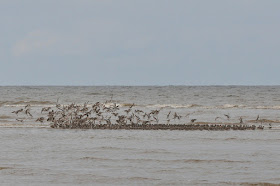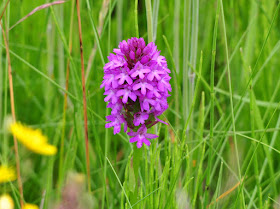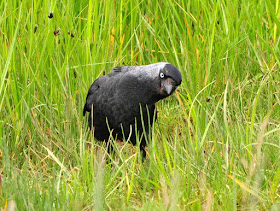We walked south along the strandline for a mile or so before gradually working our way out towards the incoming tide. The dogs got a good run but they were brought under control well before we got near to any roosting or feeding birds to avoid causing any disturbance.
 |
| Good numbers of Cormorants were gathered at intervals along the beach. |
 |
| The vast majority of the Cormorants were pale-bellied sub-adults. |
 |
| Surprisingly the longer legged Oystercatchers were the first to leave the rapidly shrinking sand bar. |
 |
| The Knot pushed closer and closer together as the tide rose. |
 |
| Eventually they had to move. |
 |
| It wasn't long before the tide moved them and us on again. |
 |
| I estimated that there were about 400 Knot and no I haven't gone through them to check. |
 |
| The roller coaster and tower are approximately 20km and 22km north from this part of Ainsdale beach. |
 |
| There were about 100 Cormorants in this roost including a few that are just out of the frame. |
 |
| I would like to claim that I intended to capture the flying bee in this photo but I obviously didn't. However, the Skylark is in there on purpose. |
 |
| The Skylark was by a path and it allowed me to approach to within a few metres. |
 |
| Squatting down changed the background to one of a hazy blue sky. The impressive hind claw can be clearly seen. |
 |
| As big and as white as it is we nearly missed this Little Egret. |
 |
| Grey Heron. |
 |
| Pyramidal Orchid |
 |
| Broad-leaved Everlasting Pea added a real splash of colour. |
 |
| Adult Jackdaw |






























